Singapore Comics: Panels Past and Present
With great power comes great responsibility. Jacqueline Lee and Chiang Yu Xiang use their power to give us an overview of the history of comics in Singapore.
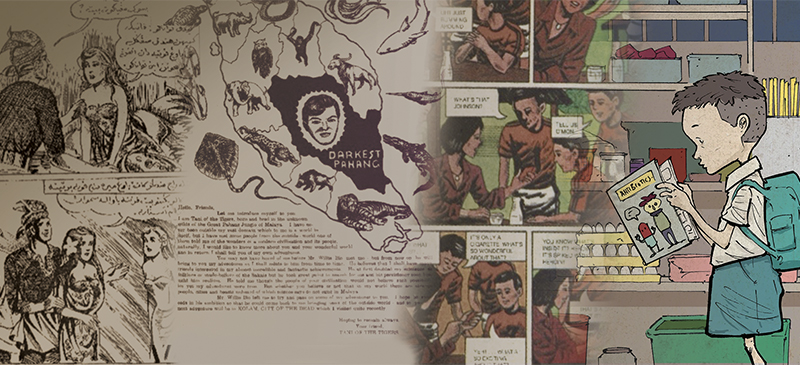
Since the first comic book, The Glasgow Looking Glass – which poked fun at the fashion and politics of 19th-century Scottish society – was published in Glasgow in 1825,1 comics have become more and more mainstream and popular. Comics these days are used to educate, entertain, lampoon, satirise and provoke.
Today, Singapore has a thriving local scene with homegrown comic book artists and writers. Life in the city-state is a fertile backdrop for many budding comic artists. As Sonny Liew, who wrote the award-winning graphic novel The Art of Charlie Chan Hock Chye (2015), notes: “Artists often write about what they know, so stories set in Singapore or with a local flavour are a natural step.”2
When people talk about local comics today, what come to mind are popular comic series such as Mr Kiasu and Liew’s The Art of Charlie Chan Hock Chye. However, there are other works by Singaporean comic book artists that are equally well received and have won awards as well.
Award-winning Comics
The Eisner Awards are sometimes referred to as the comics industry’s equivalent of the Academy Awards. In 2017, Liew’s The Art of Charlie Chan Hock Chye won three Eisner Awards. However, this is not the only comic book to have attained international success. Moving Forward is a short comic by Drewscape (whose real name is Andrew Tan) that was nominated for an Eisner Award for Best Short Story in 2013.3
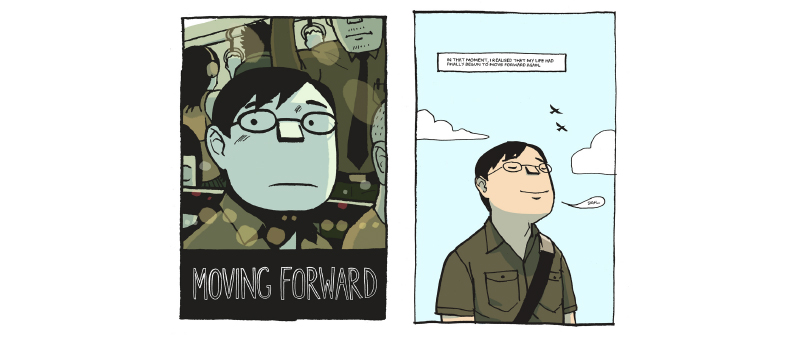
Another award-winning comic book is Koh Hong Teng’s Ten Sticks and One Rice (2012) which clinched the third prize at the 7th International Manga Awards 2014 in Japan. In 2009, Koh had adapted Dave Chua’s award-winning novel Gone Case into a two-volume comic book. (Gone Case is a coming-of-age story set in a public housing estate, which won the Singapore Literature Commendation Prize in 1996.)
Many popular comic books in Singapore today are autobiographical or semi-autobiographical. Lim Cheng Tju, an educator and an author and editor of comic books, notes that while autobiographical comics are considered an alternative genre in the United States, they are considered mainstream in Singapore. The majority of comic artists in Singapore are hobbyists and rely on government grants to fund their comic book projects.4 With many comic artists choosing to tell personal stories or pursue passion projects instead of trying to appeal to the mass market, the autobiographical genre has become mainstream here.
Ten Sticks and One Rice is an example of this phenomenon. Produced by Koh Hong Teng together with Oh Yong Hwee, it is based on the creators’ hawker parents. Another example is Troy Chin’s The Resident Tourist series of graphic books. These recount interesting snippets of Chin’s life in Singapore as a “tourist” following his return here after a nine-year stint in the United States.5
More recently, we have Chronicles of a Circuit Breaker by cartoonist Joseph Chiang. Between April and June 2020, Singapore entered a “circuit breaker” period where schools and most workplaces were closed to break the chain of infection resulting from the Covid-19 pandemic. In his book, Chiang documents life during the two months and summarises some key lessons that he learnt from the period.
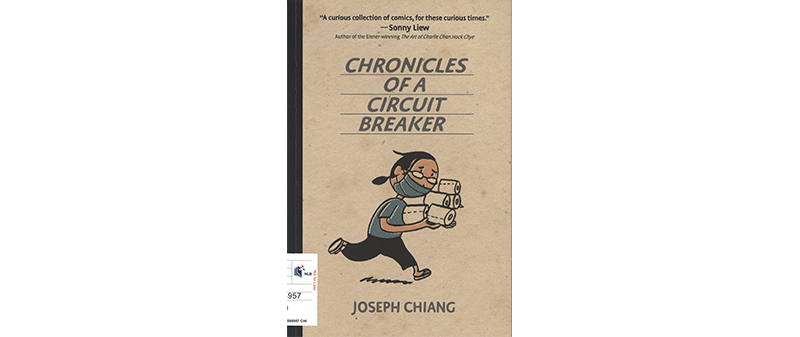
Launchpads for Comics
Many comic books started out as regular comic strips in the dailies. From the Straits Times, there is The House of Lim by Cheah Sin Ann and Chew on It! by Lee Chee Chew that provide incisive social commentary on Singapore and poke fun at local foibles and idiosyncrasies.
Several 联合早报 (Lianhe Zaobao) comic strips have also been compiled into volumes. Ang Thiam Poh’s 又是这一班 (You Shi Zhe Yi Ban; It’s This Class Again) is a six-volume series about school life.6 Chua Sin Yew’s 新鲜阿婆 (Xin Xian A Po; What’s New With Grandma?) is set in the local neighbourhood and looks at Singapore through the eyes of its geriatric protagonist, an incurable optimist.7
笑看城市人 (Xiao Kan Cheng Shi Ren; Looking at City Folks) by Wu Yu (whose real name is Goh Ting Cheng) is a collection of the best 500 strips from the series 朝九晚五 (Zhao Jiu Wan Wu; Nine to Five) in Lianhe Zaobao. Wu’s comic strips focus on the daily struggles of white-collar workers. Meanwhile, 新加坡啦 (Xin Jia Po La; Singapore Lah) by Goh Kar Hoe (Wu Jiahe) comments on the headlines of the day.
In Singapore, veteran comic artists have readily taken newbies under their wings. Wee Tian Beng, the creator of the Celestial Zone comic series, has mentored several artists such as Yeo Hui Xuan for the Dream Walker series (2009–18), Clio Hui Kiri for A Deal with Lucifer (2015–17) and Shen Jiahui for The Makeup Toolbox (2018–19). In 2018, Johnny Lau, one of the creators of Mr Kiasu, worked with artist Rick Chen on the creation of a comic series titled SupeRich. The second volume of this comic book was published in 2020.8
There have also been efforts to raise the profile of Singaporean comic artists by promoting their works through platforms like Comix.sg, an online directory and archive of comic creators born and/or based in Singapore and their works. This directory was launched in April 2020.
In the following sections, we look at some major comic genres and introduce interesting comics available in the National Library’s collections.
COMIC ANTHOLOGIES
Anthologies are a popular format for comics. A number of collections have been published over the years and these have helped to bring many artists to prominence.
PAST…
漫画同盟 (Comics Alliance) – a four-volume anthology series published in 1997, 1998 and 2001 – is a compilation of Chinese comics by various Singaporean comic artists. The books are edited by comic veterans Wee Tian Beng and Wee See Heng.
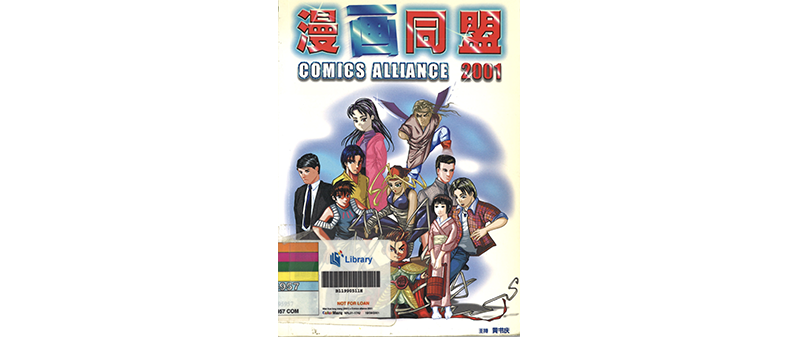
The Liquid City anthology, the brainchild of Sonny Liew, brought together a star-studded cast of artists who contributed short comics that have been compiled in three volumes. The series has received much attention, with volume two being nominated for Best Anthology Series at the 2011 Eisner Awards. Many of the participating artists went on to produce their own comic books. Otto Fong, a contributor to the anthology, said: “The experience of being in an anthology and working alongside other comics artists spurred my competitiveness.”9
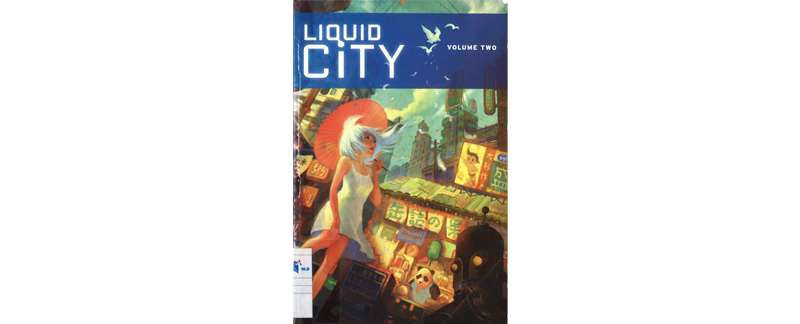
PRESENT…
In 2015, when Singapore celebrated 50 years of independence, a comics publication titled Our Months Together, comprising 12 stories representing the 12 months in a year, was published. That same year also saw the publication of Mr Kiasu in Singapore History, which brought the titular character back to different periods in Singapore’s history.
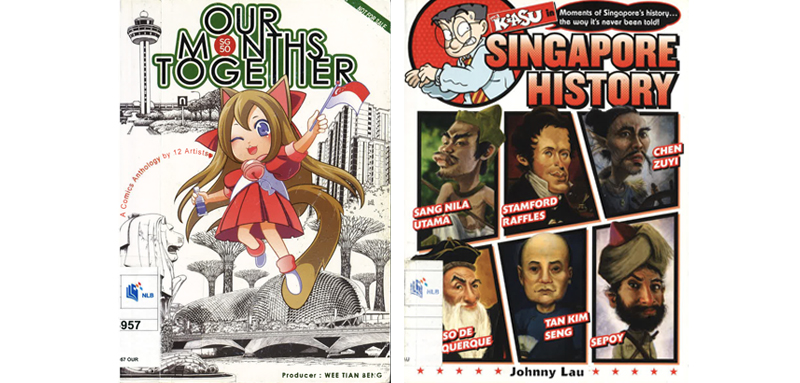
In 2020, the Difference Engine – an independent comics publisher based in Singapore – released its first anthology titled Sound: A Comics Anthology. The publication is a showcase of 13 comics by writers and illustrators from across Southeast Asia in response to sound.

SUPERHEROES
Mention comics and most people automatically associate it with characters such as Superman and Wonder Woman. Superman popularised the superhero genre and inspired others to create their own superheroes, including in Singapore.
PAST…
One of the earliest local comic book superheroes is Pluto-man, who swooped onto the scene in 1983. He is the eponymous hero in The Valiant Pluto-man of Singapore by Roger Wong. Aliens from the planet Pluto transform an ordinary man named Po Shan into Pluto-man by shooting plutonic electrons into his body. They instruct him to “use [his] might and power to fight crime, and help those in need”. The aliens also give Po Shan a ring that aids in his transformation and which also doubles up as a weapon that can emit freeze rays.
With his newfound powers – super strength, super speed, flight and a “plutonic instinct” for fighting crime – Pluto-man goes on a crime-busting spree, including foiling a bank heist involving a fake Merlion.
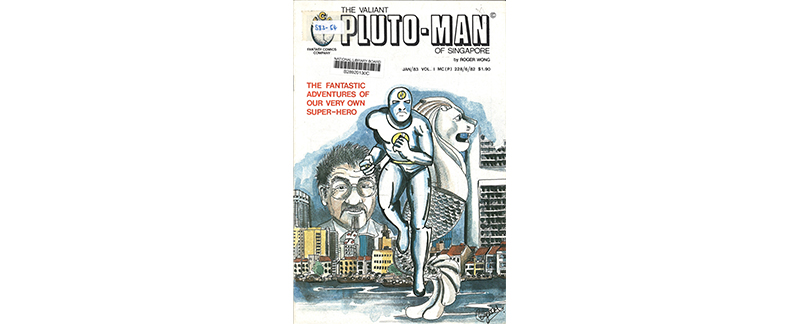
In 1985, the Singapore Police Force unveiled Captain V as the mascot for the National Crime Prevention Council. Captain V’s mission was to explain crime prevention to children and their role in the fight against crime.10 At the launch, a 3.65-metre-tall model of Captain V stood atop a bus, which crashed through a paper wall at the Police Academy on Thomson Road to reveal Captain V himself.11
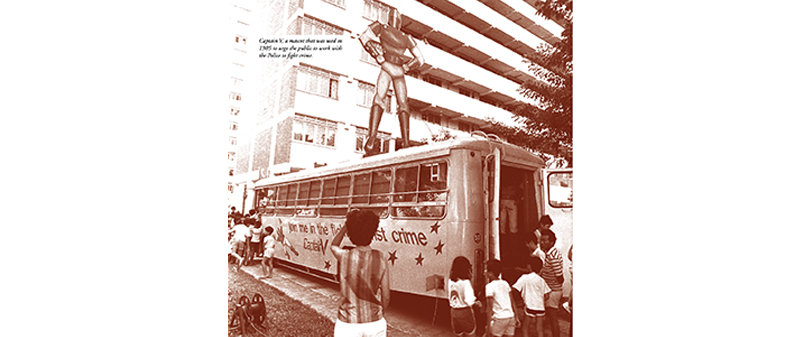
In 1987, Captain V was given his own comic book series when the first issue of The Amazing Adventures of Captain V was launched at Singapore’s second comics convention (Comicon ’87). Although Captain V combats crime using technology such as jet boots, he does not possess any inherent superpowers but has qualities such as vigilance and valour.
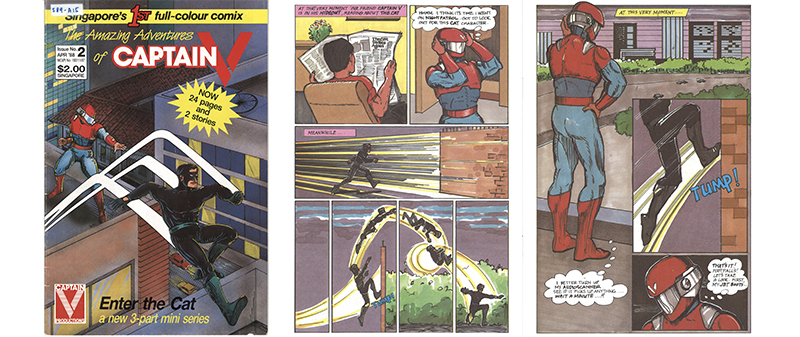
As a sidenote, while not strictly a superhero comic, among the older comics in the National Library is Python Gang by Ronald Wild. Written in English, Chinese and Malay, the comic revolves around police investigations into a criminal syndicate called the Python Gang. While it was printed in Singapore, there are no details about the publisher or year of publication. However, we do know that the comic has been in the National Library’s Legal Deposit collection since 1963.
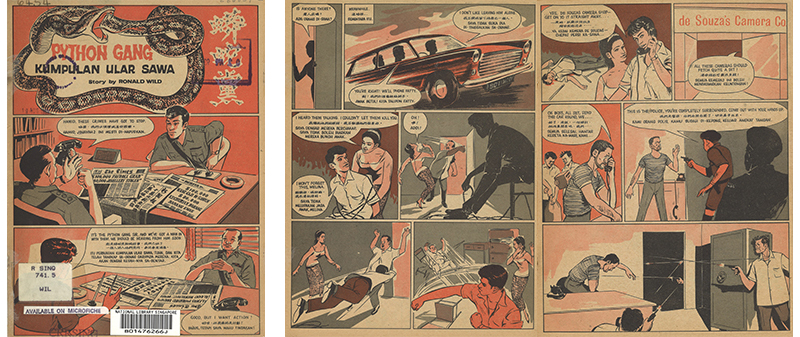
PRESENT…
The Dim Sum Warriors (点心侠; Dian Xin Xia) series is the creation of husband-and-wife duo Colin Goh and Woo Yen Yen, of the TalkingCock.com satirical website and the Coxford Singlish Dictionary fame.12 The series features a colourful cast of familiar dim sum such as cha shao bao (roast pork bun), xia jiao (shrimp dumpling) and shao mai (pork and shrimp dumpling), imagined as kungfu warriors. The idea was conceived out of the couple’s love for dim sum and kungfu movies.
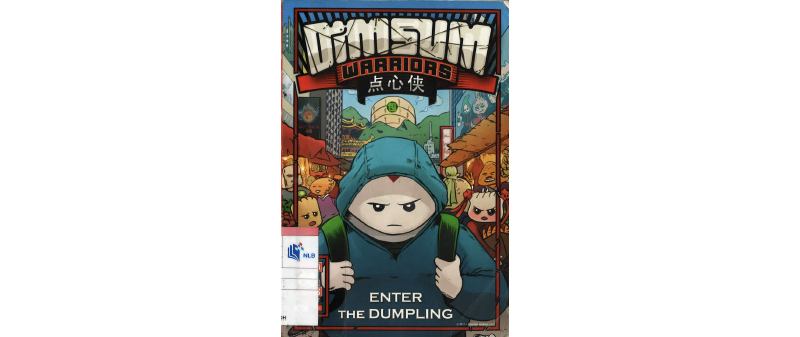
The bilingual comic book was first published in 2012 and later adapted into a musical that toured major Chinese cities.13 In 2019, the couple launched a spin-off storybook series for children as well as an educational app for children to learn Mandarin.14
Special mention should also be made of Sacred Guardians (2020) by Adyeel Djoeharie and illustrated by Alan Bay. Supported by the National Arts Council, this comic book is a prequel story to “Sacred Guardian Singa: A Singapore Superhero Project”. Sacred Guardian Singa is a “Tokusatsu superhero character rooted in the real culture, history and heritage of Singapore and Southeast Asia”.15 (Tokusatsu is a Japanese term for live-action film or television drama that makes heavy use of special effects.)
Set in the 7th century on the island of Tumasik (Temasek), the story follows the quest of the immortal scribe Dev who gathers a group of “sacred guardians” with special powers to fight an invasion by the evil demon king. In June 2021, Sacred Guardians became the first local comic book to be made into an audio drama.
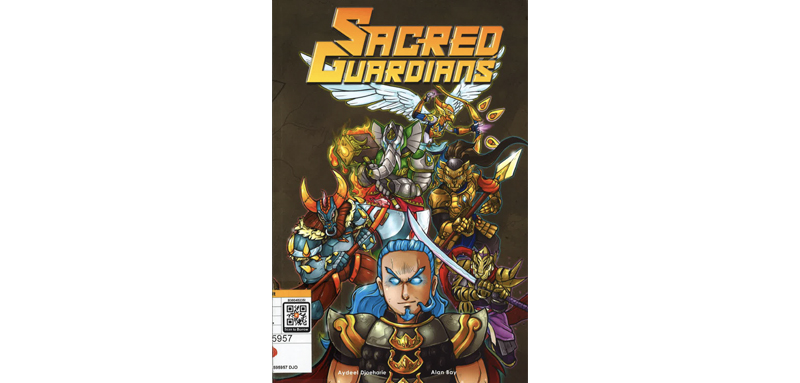
INFORMATIONAL/EDUCATIONAL
Various organisations, companies and government agencies in Singapore have used comics as a medium to convey important information and messages in an effective yet highly entertaining manner.
One of the best examples is the poster on toilet etiquette found in public toilets across Singapore. Rendered in a comic strip format, these posters are a collaboration between the National Environment Agency and the cartoonist Lee Chee Chew as part of the Clean & Green Singapore campaign.16
Another example of an educational comic is Otto Fong’s popular “Sir Fong’s Adventures in Science” comic series that impart scientific concepts in a fun and accessible way. Fong drew on his many years of experience as a secondary school science teacher for his comic series featuring a teacher who is a monkey and his student-rabbits.
PAST…
Published by the Singapore Anti-Narcotics Association in 1979, What If They Call Me Chicken? is a cautionary tale about the dangers of taking drugs. A schoolboy named Kok Meng is offered a cigarette laced with drugs. While his friends agree to try it, he turns it down and goes home and tells his parents what had happened. Kok Meng is called a “chicken” for saying no to drugs, but he is vindicated in the end as his friends are arrested and punished. The message is blunt and direct: taking drugs is wrong and will ruin your life.

PRESENT…
Graphic medicine is a genre in which comics are used as a medium for communicating about medicine and healthcare.17 Examples of local comics in this category include All That Remains (2018) and All Death Matters (2020) about dementia, and end-of-life and palliative care respectively. Created by James Tan and funded by the Lien Foundation, the two comics aim to initiate “die-logues” about taboo topics such as death and illness and to start thinking about palliative care planning.
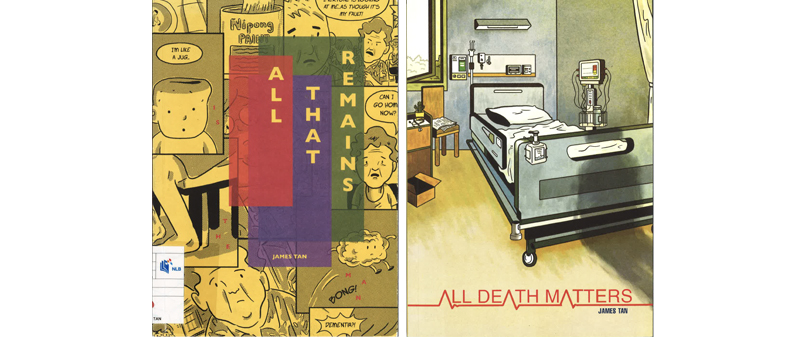
(Right) This graphic medicine talks about end-of-life and palliative care. Image reproduced from James Tan, All Death Matters (Singapore: Lien Foundation, 2020). (From National Library, Singapore, Call no. RSING 741.59597 TAN).
In The Antibiotic Tales (2019), Sonny Liew partnered infectious diseases physician Hsu Li Yang to create a cautionary tale of an apocalyptic future because of a general resistance to antibiotics.
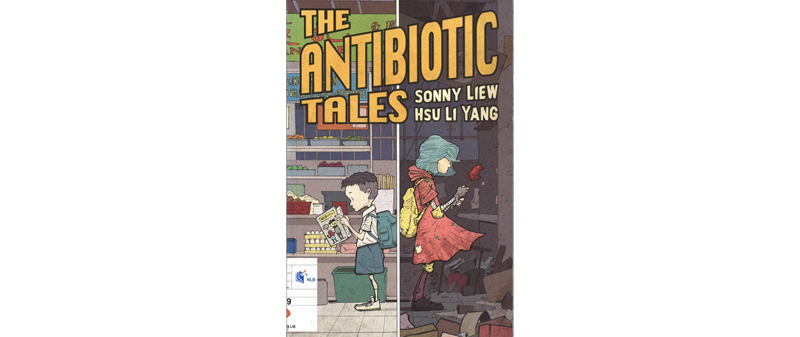
MYTHS AND LEGENDS
Publisher Asiapac Books produces English comic titles on Chinese classics like the story of Mulan to get the younger generation interested in Chinese culture and literature.
There are also locally published comics inspired by local legends. In the Chinese comic, 女侠红头巾: 大战油鬼仔 (The Samsui Sword; 2021), the protagonist takes on the orang minyak, or oily man, a supernatural creature from Malay folklore who is coated in black oil and preys on young women. And in The Secret of Redhill (2015), a group of students go back in time to relive the legend of Bukit Merah.
PAST…
Published in 1949, Tani of the Tigers is an adventure comic and a Malayan spin on legends like The Jungle Book and Tarzan.18 It tells the story of Tani, an orphaned child raised by tigers in the Pahang jungle of Malaya and who is able to converse with animals. An advertisement in the Malaya Tribune described it as being “drawn, written & published by Malayans” and that it “[excelled] any American comics published overseas!”19
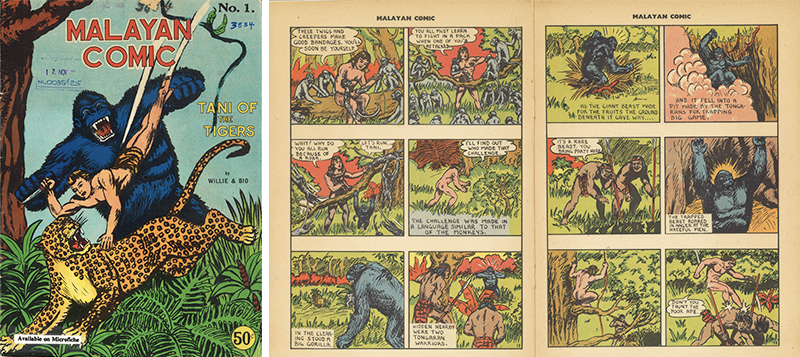
Tani was perhaps inspired by the highly successful Tarzan novels and film adaptations which were all the rage at the time.
In the 1950s, one of the early publishing houses in Singapore that published comic books was Geliga. The comics were produced in Jawi and included Malay folktales and contemporary tales in Malay society.
Nora Abdullah, also known as Nek Norzarah Abdullah, was Geliga’s first female cartoonist and also the first known Malay female cartoonist in Singapore and Malaya.20 Born in Kelantan, Nora Abdullah was only 15 years old when she published her first comic book with Geliga in 1955, titled Cik Siti Wan Kembang.21 Siti Wan Kembang is the legendary queen who ruled Kelantan in the 17th century. She was renowned for her wisdom and mystical powers, and rode to battle on horseback armed with a sword and accompanied by an army of female warriors.
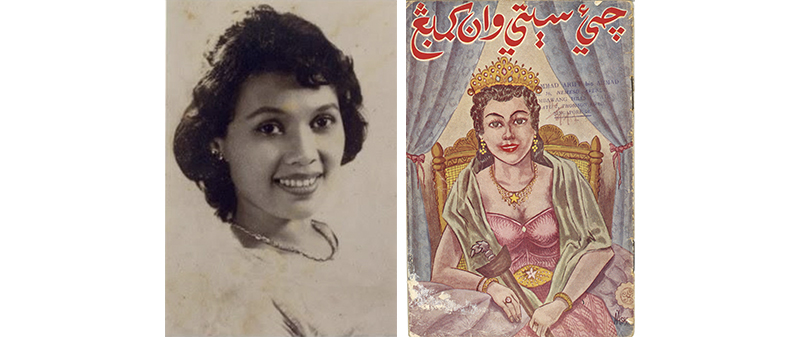
(Right) Siti Wan Kembang is the legendary queen who ruled Kelantan in the 17th century. Image reproduced from Nora Abdullah, Cik Siti Wan Kembang (London: The British Library, [2010–2013]). (From National Library, Singapore, Call no. Malay RCLOS 899.28 NOR).
Between 1955 and 1961, Nora Abdullah published at least 12 comic books with Geliga, including Bawang Puteh Bawang Merah (1957), which is based on an Indonesian folktale about a gentle and obedient village girl living with her evil stepsister and stepmother. The village girl eventually marries a prince.
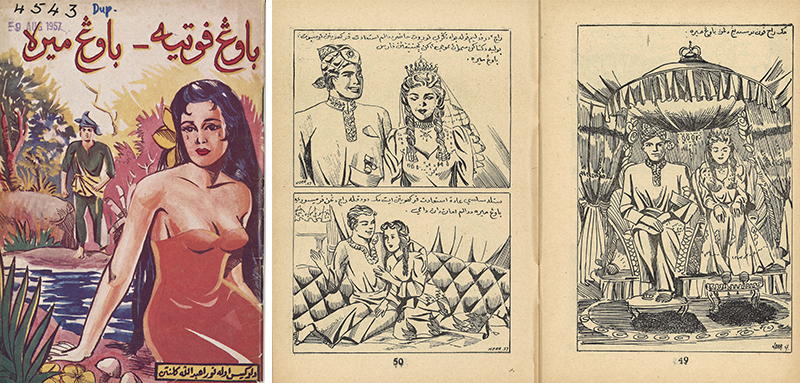
PRESENT…
The Comics of Singapore Histories (COSH Studios) – a collective of artists and writers – has produced seven graphic novels on local history between 2017 and 2018, with funding from the National Heritage Board. These comics offer stories relating to Singapore history and heritage but with a speculative twist. From supernatural encounters in Bukit Brown Cemetery (Final Resting Place) to cooking chicken rice in a zombie apocalypse (We’ll Eat When We’re Done), COSH comics present Singapore stories in a creative and fun way, reinterpreting familiar situations in new and witty ways.
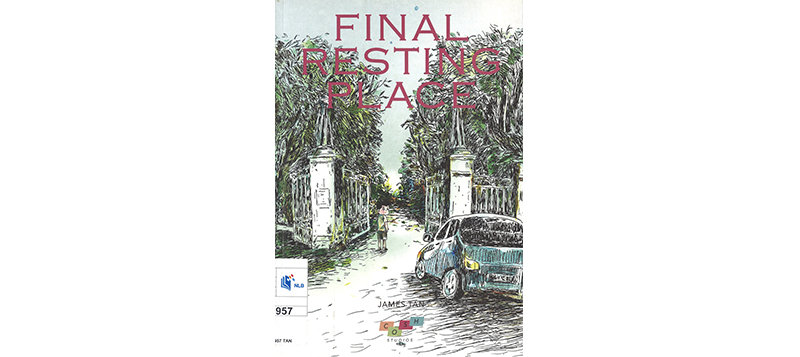
HISTORY AND POLITICS
Political cartoons tend to focus on issues of the day that matter to the man in the street. Many comic strips and single panel political commentaries in local newspapers have been published as a collection, such as Hello Chok Tong, Goodbye Kuan Yew (1991), which pokes fun at Singapore politicians as well as Singaporeans and their lifestyle, and The Year in Cartoons by the cartoonists of the Straits Times (published in 1997, 1998, 1999 and 2000).
Lim Cheng Tju notes that political cartoons in Singapore walk a fine line between a consensus-shaping role in the nation-building process and allowing cartoonists to exercise their creativity in the political space.22
PAST…
Straits Produce was first published in 1868, making it possibly the first comic to be published in Singapore. It aimed to provide “an abstract and brief chronicle of our time, with lines lightly touched in with pen and pencil, hitting off good-naturedly the chief features of the topics of the moment, and holding up the mirror of not unkindly humour to Straits men and Straits affairs”.23 It was started in response to then Governor of the Straits Settlements Harry Ord’s financial policy, which it roundly criticised through caricature and cartoon.
In 1932, Dream Awhile: Cartoons from Straits Produce Showing in Pictorial Form the Main Events in Local History was published.24 The volume was produced to commemorate 10 years of continuous publication of Straits Produce and is probably the earliest publication of local political cartoons in the National Library’s collection.
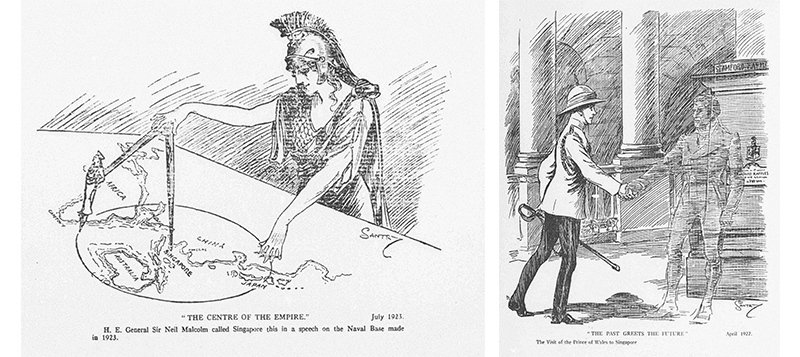
(Right) Captioned “The Past Greets the Future,” the cartoon was drawn on the occasion of the Prince of Wales’s visit to Singapore in April 1922. He is depicted shaking hands with the ghost of Stamford Raffles.
Both images reproduced from Dream Awhile: Cartoons from Straits Produce Showing in Pictorial Form the Main Events in Local History (Singapore: Printers, 1932). (From National Library, Singapore, Call no. RCLOS 959.5 STR-[RFL].
A better-known example of a comic that tackles history and politics is Liu Kang’s Chop Suey, which records the horrors of the Japanese Occupation in Singapore (1942–45). First published in 1946, and with reprints thereafter, Chop Suey is a four-volume publication (three in English and one in Chinese) of charcoal sketches and caricatures.25 Liu and his friend, Zheng Zhenen, had collected stories from people who suffered during the Occupation, and these were depicted in the illustrations showing the various ways in which the Japanese tortured prisoners-of-war to force confessions. Liu’s work remains a poignant record of wartime memories.26

(Right) Sharp pencils being poked into the ears of a prisoner as a form of torture. Image reproduced from Liu Kang, Chop Suey, vol. 1 (Singapore: Eastern Art Co., 1946). (From National Library, Singapore, Call no. RRARE 959.5106 CHO; Accession no. B02901745F).
PRESENT…
In conjunction with the 90th anniversary of Lianhe Zaobao in 2013, Singapore Press Holdings organised an exhibition titled “A Collection of our Shared Memories”, featuring comics published in the Sin Chew Jit Poh, Nanyang Siang Pau and Lianhe Zaobao Chinese newspapers between 1929 and 2013. In 2015, more than 100 of these comics were compiled and published into a book, offering a glimpse into the daily lives of people in the past. Many of the works are a form of social commentary – reflecting the changing social, political and economic conditions in Singapore over the decades.
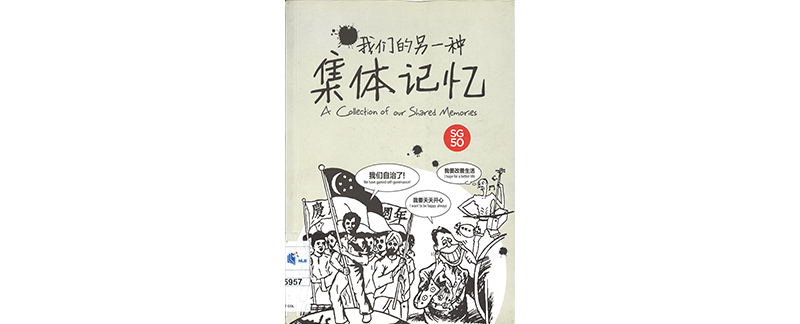
Sonny Liew’s The Art of Charlie Chan Hock Chye, while difficult to place in a specific genre, can be argued to be a work based on Singapore’s history, even as it modifies and retells it. The story, which provides an alternative lens into Singapore’s mid-20th-century history through the eyes of a fictitious comic artist, has been interpreted by critics as metafiction, an allegory or a satire of the “Singapore story”, and a homage to comics. A year earlier, in 2016, when the comic won the Singapore Literature Prize, it earned the distinction of being the first graphic novel ever to clinch the award.27
With Minister Mentor Lee Kuan Yew’s passing in 2015, several biographical works in comic book form were published about him. These include Morgan Chua’s L.K.Y. Political Cartoons, which covers Lee’s political career over the decades, and Yoshio Nabeta’s manga, The LKY Story: Lee Kuan Yew, the Man Who Shaped a Nation and The Story of LKY.
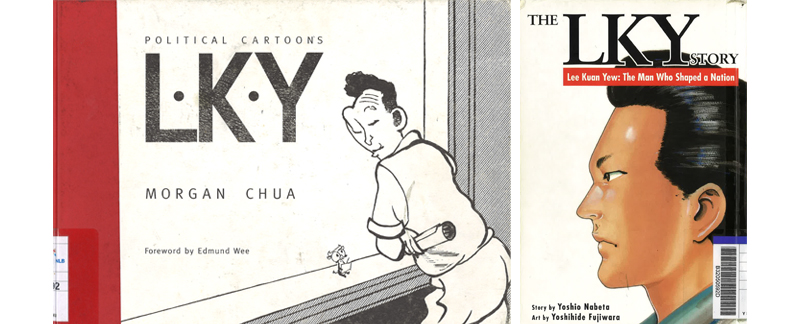
(Right) This manga is a tribute to Singapore’s founding prime minister and also commemorates 50 years of Singapore-Japan diplomatic relations. Image reproduced from Yoshio Nabeta and Yoshihide Fujiwara, The LKY Story: Lee Kuan Yew, the Man Who Shaped a Nation (Singapore: Shogakukan Asia, [2016]). (From National Library, Singapore, Call no. RSING 959.5705092 NAB).
Promoting Comics at the National Library Board
Besides building a collection of comics, the National Library Board (NLB) has hosted various comics events to increase the profile of local comic creators and spark interest in creating comics.
In 2005, NLB hosted the first Comix Jam at the National Library Building, followed by the 24-hour Comics Day Challenge at Bukit Merah Public Library in 2012 and a 12-hour variation at library@harbourfront in 2019.28 These were held in the “draw-a-thon” format that allowed participants an uninterrupted period of time to create comics (for the 24-hour Comics Day Challenge, participants had to create 24 pages of comics within 24 hours).
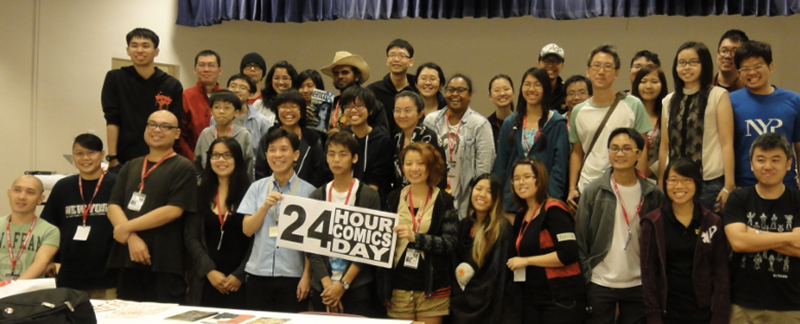
NLB has also hosted longer comics workshops where participants underwent a comprehensive editorial and mentorship process of comic creation, with peer review of comic drafts. An extension of the 24-hour Comics Day Challenge, the first Panelgraph (the authoring of stories using comic-book panels) sessions were held at Toa Payoh Public Library from 2015 to 2016. The comics created during the sessions were compiled as digital issues and made available on the Panelgraph website.29
In 2016, Tampines Regional Library was the venue for Places, a 13-week art co-creation workshop organised as part of the Community Arts & Culture Nodes initiative of the National Arts Council. Under the guidance of Gwee Li Swee – poet, graphic artist and author of several books, including the graphic novel Myth of the Stone – participants created comics with a select few compiled into an anthology.
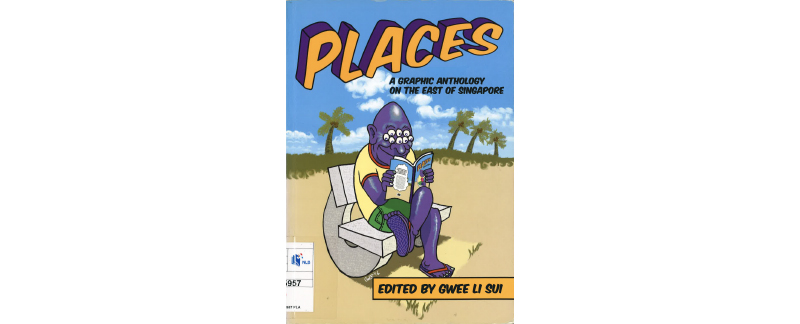
In the same year, Central Public Library played host to Speech Bubble, a month-long event comprising talks, workshops and an exhibition showcasing artefacts, books and original artworks from comic artists. Conceptualised by Sonny Liew and Lim Cheng Tju, the objective of the event was to celebrate Singapore comics and their rich and colourful history.30
NLB is also a venue sponsor of the Singapore Original Comics Festival, a month-long annual comic-based event that focuses on creating original content by Singaporeans. Organised by the Comics Society (Singapore) since 2015, the festival hopes to uncover new local talents and present new comic works. In 2019, a comics exhibition, a book launch and a panel discussion were held at Jurong Regional Library.31
Gwee Li Sui’s “How to Fall in Love with Classics”, a popular series of lectures on literary classics organised by NLB, focused on graphic novels in the 6th instalment in April 2020. One of the graphic novels discussed was The Art of Charlie Chan Hock Chye (the recorded lecture is available online).32
With all these ongoing efforts and initiatives by comic groups and societies in Singapore as well as various government grants, the comics scene is set to take off, or as Superman might say, to go “up, up and away”.
 Jacqueline Lee is an Associate Librarian with the National Library, Singapore, who works with the Singapore and Southeast Asia collections. Her responsibilities include developing and promoting the Legal Deposit and Web Archive Singapore collections.
Jacqueline Lee is an Associate Librarian with the National Library, Singapore, who works with the Singapore and Southeast Asia collections. Her responsibilities include developing and promoting the Legal Deposit and Web Archive Singapore collections. Chiang Yu Xiang is an Associate Librarian with the Public Libraries, Singapore. He has had the opportunity to meet and work with many creative Singaporean comic artists.
Chiang Yu Xiang is an Associate Librarian with the Public Libraries, Singapore. He has had the opportunity to meet and work with many creative Singaporean comic artists.NOTES
-
“Have I Got Old News for You: Glasgow is Home to World’s Oldest Comic,” The Herald, 24 June 2013, https://www.heraldscotland.com/life_style/arts_ents/13110858.got-old-news-glasgow-home-worlds-oldest-comic/. ↩
-
Benson Ang, “Local Comics Nothing to Laugh At,” New Paper, 13 October 2013. (From NewspaperSG) ↩
-
Drewscape, or Andrew Tan, compiled Moving Forward, along with 15 other comics, into an anthology titled Monsters, Miracles and Mayonnaise. ↩
-
Lim Cheng Tju, “Current Trends in Singapore Comics: When Autobiography is Mainstream,” Kyoto Review of Southeast Asia, no. 16 (2014, September), https://kyotoreview.org/issue-16/current-trends-in-singapore-comics-when-autobiography-is-mainstream/. ↩
-
The Resident Tourist series of books is available at the Lee Kong Chian Reference Library and at selected branch libraries. Check the catalogue for details. Read The Resident Tourist in web comic form, Webtoon, accessed 19 August 2021, https://www.webtoons.com/en/challenge/the-resident-tourist/list?title_no=248877. ↩
-
Ang Thiam Poh has another comic series, 跳班 (Tiao Ban; Jump Class), also set in the classroom and written with Johnny Lau. Both series are available at the Lee Kong Chian Reference Library and at selected branch libraries. Check the catalogue for details. ↩
-
The books are available at the Lee Kong Chian Reference Library and at selected branch libraries. Check the catalogue for details. ↩
-
All these comic series are available at the Lee Kong Chian Reference Library and at selected branch libraries. Check the catalogue for details. ↩
-
Rebecca Lynne Tan, “Feeling Lucky to be with Lat,” Straits Times, 12 April 2009, 57. (From NewspaperSG) ↩
-
Susan Sim, Making Singapore Safe: Thirty Years of the National Crime Prevention Council (Singapore: Marshall Cavendish Editions, 2011), 22. (From National Library, Singapore, Call no. RSING 364.4095957 SIM) ↩
-
“Captain V Reports for Duty Against Crime,” Straits Times, 11 September 1985, 8. (From NewspaperSG) ↩
-
Goh and Woo directed the critically acclaimed movie Singapore Dreaming (2006). Goh previously worked on a long-standing comic strip, Orchard Road, published in The New Paper. The comics have been compiled into three volumes. ↩
-
Olivia Ho, “Kungfu Dim Sum Musical Written by Singaporean Couple Takes off in Shanghai,” Straits Times, 19 August 2017, https://www.straitstimes.com/lifestyle/arts/kungfu-dim-sum-musical-written-by-singaporean-couple-takes-off-in-shanghai. ↩
-
Tan Dawn Wei, “Colin Goh: From Talking Cock to Speaking Mandarin,” Straits Times, 20 July 2019, https://www.straitstimes.com/lifestyle/arts/from-talking-cock-to-speaking-mandarin. ↩
-
“Sacred Guardian Singa,” tokuAsia Pte Ltd, accessed 22 August 2021, https://sacredguardians.tv/. ↩
-
“Posters,” National Environment Agency, last updated 2 July 2020, https://www.nea.gov.sg/corporate-functions/resources/educational-materials/posters. ↩
-
The term “graphic medicine” was coined in 2007 by Dr Ian Williams, a comic artist and physician. The international movement to promote graphic medicine works can be found at Graphic Medicine, a site that explores the interaction between the medium of comics and the discourse of healthcare. See “Graphic Medicine,” Graphic Medicine International Collection, accessed 22 August 2021, https://graphicmedicine.org. ↩
-
Willie and Bio, Tani of the Tigers (Singapore: Keng Yan Leng, [19–]). (From PublicationSG). ↩
-
“Page 7 Advertisements Column 1,” Malaya Tribune, 6 September 1949, 7. (From NewspaperSG). ↩
-
Special thanks to the Malay Heritage Centre for providing more information on Nora Abdullah as they had done a write-up on Nora Abdullah for their “Women in Action” exhibition in 2018. Lim Cheng Tju has interviewed Nora Abdullah. See Lim Cheng Tju, “‘Art is My Blood’: A Short Interview with Nora Abdullah, Pioneer Female Malay Comic Artist,” International Journal of Comic Art 19, no. 1 (Spring/Summer 2017). (From National Library, Singapore, Call no. R 741.505 IJCA) ↩
-
NLB has the reprint. See Nora Abdullah, Cik Siti Wan Kembang (London: The British Library, [2010–2013]). (From National Library, Singapore, Call no. Malay RCLOS 899.28 NOR) ↩
-
Lim Cheng Tju, Cartoons of Our Lives, Mirrors of Our Times: History of Political Cartoons in Singapore, 1959–1995 (Singapore: National University of Singapore, 1995), 3. (From National Library, Singapore, Call no. RSING q741.595957 LIM). The article can also be accessed at https://www.academia.edu/14994791/Singapore_Political_Cartooning. ↩
-
“Straits Produce,” The Singapore Free Press and Mercantile Advertiser (Weekly), 2 January 1894, 443. (From NewspaperSG) ↩
-
Straits Produce, Dream Awhile: Cartoons from Straits Produce Showing in Pictorial Form the Main Events in Local History (Singapore: Printers, 1932). (From National Library, Singapore, Call no. RCLOS 959.5 STR-[RFL]) ↩
-
Liu Kang, Chop Suey, 4 vols (Singapore: Eastern Art Co., 1946). (From National Library, Singapore, Call no. RRARE 959.5106 CHO); Timothy Pwee, “Cartoons of Terror,” in The Rare Materials Collection: Selections from the National Library (Singapore: National Library Board, [2020]), 102–105. (From National Library, Singapore, Call no. RSING 016.95957 SIN-[LIB]) ↩
-
For a further reading on Chop Suey, see Lim Cheng Tju, “Chop Suey – Cartoons About the Japanese Occupation and National Education in Singapore,” International Journal of Comic Art 6, no. 2 (Fall 2004): 415–30. (From National Library, Singapore, Call no. R 741.505 IJCA) ↩
-
The launch of Charlie Chan in May 2015 was not without controversy. The National Arts Council publicly withdrew its S$8,000 grant on the eve of its official book launch due to “sensitive content”, particularly in the retelling of Singapore’s history, which “potentially undermines the authority or legitimacy of the government and its public institutions, and thus breaches our funding guidelines”. Likely as a result of the ensuing publicity, half of its first print run of 1,000 copies was sold out within a few days. ↩
-
For the history of the 24-hour Comics Day in Singapore, see http://singaporecomix.blogspot.com/2013/03/24-hour-comics-day-exhibition.html. ↩
-
The Panelgraph sessions were moved to *Scape from 2017 to 2018, and Panelgraph is today a community on Facebook. Their website (https://www.panelgraph.com) features five issues of comics created from 2015 to 2016. ↩
-
Nur Asyiqin Mohamad Salleh, “Singapore Comics Celebrated at Month-long Event Speech Bubble,” Straits Times, 2 September 2016, https://www.straitstimes.com/lifestyle/arts/comics-in-singapore-pack-a-pow. ↩
-
Find out more about the Singapore Original Comics Festival at https://www.sgocf.com. ↩
-
The links to all “How to Fall in Love with Classics” lecture videos and notes up to the 6th instalment (comics) can be found at https://www.facebook.com/notes/335051027599649/. ↩

